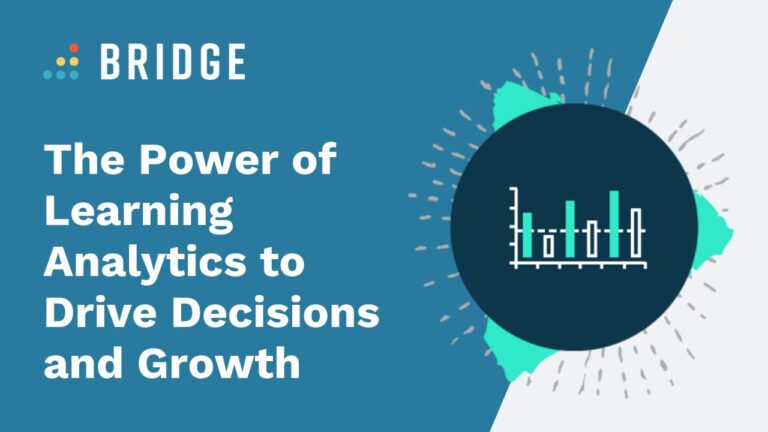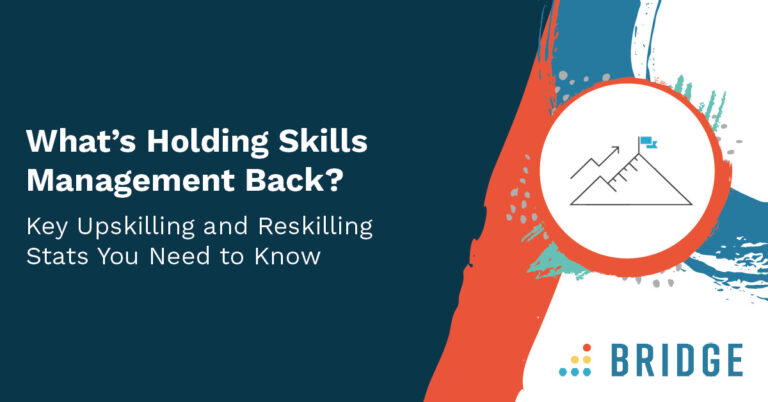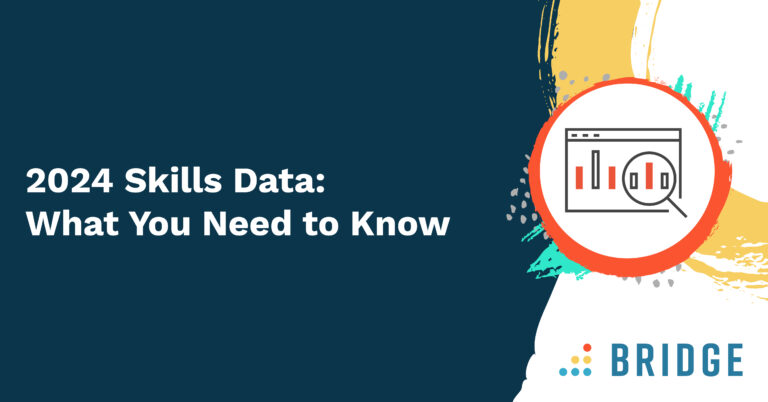Making a case for learning and development requires transparent and accessible metrics that show the impact of training across your organization. When leaders and execs see the value of L&D programs and how this translates into performance, your department is more likely to get the budget and resources you need.
Transparent goals and metrics that align workforce needs with business strategies enable greater clarity and collaboration.
A Learning Management System (LMS) with robust analytics and reporting capabilities yields relevant and actionable data, allowing organizations to make better, more informed decisions and improve outcomes.
The Importance of Learning Data Analytics
Business leaders know the importance of embedding data into processes, decisions, and strategies. According to a Salesforce report, while 80% believe that data is critical to organizational success, many aren’t using the information they have or find it hard to interpret.
To illustrate the value of an LMS to your stakeholders, drive sustainability, and enable growth, your metrics must be connected with a set of clearly defined and measurable goals.
Clarity of organizational objectives and priorities is essential to align learner goals and performance outcomes, measure the results of training, and reinforce the return on investment.
Identifying strategic objectives, using data-driven insights, and measuring the improvements and performance with analytics communicates the success of L&D programs in a way that benefits the entire organization.
WANT TO EXPLORE L&D BEST PRACTICES TO FUEL GROWTH? READ THIS! | ‘How Learning and Performance Can Connect, Align, and Grow Your Organization’
LMS Reporting and Analytics Metrics to Increase the Effectiveness of Your L&D Programs
Here are seven ways reporting and analytics translates your learning data into tangible results:
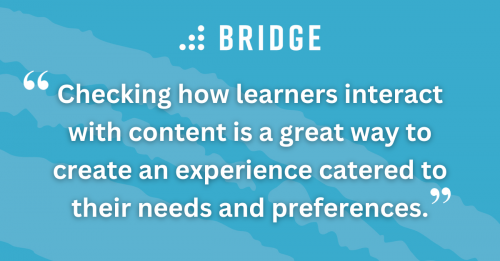
1) Learning Management System Usage Metrics
The most straightforward way to gauge success is whether employees use your learning platform.
Usage metrics such as unique logins and month-by-month changes show what value learning programs add to your people, their motivation to progress with training, and how easy the platform is to search and navigate.
Tracking learner activity can offer an overview of engagement both at an organizational level and a more granular view of individual learner behavior and activity. If user engagement is low or there are trends across teams or departments, schedule one-on-ones to delve deeper.
DISCOVER MORE WAYS TO SHOW THE ROI OF EMPLOYEE DEVELOPMENT | ‘Making the Case for Your Learning Platform in a Time of Economic Uncertainty’
2) Course Enrollment and Progress Rates
Measures such as completion rate, activity status, and progress are all signifiers of whether people are advancing through courses and how they’re engaging with the material. It’s a handy way to keep learners on track with assigned and mandatory training and shows that your content is driving them to keep learning.
With this information, you can more easily create engaging and memorable content that sparks enthusiasm. On the other hand, a high dropoff rate or learners stalled at the same point could indicate that courses aren’t engaging or the material lacks relevance.
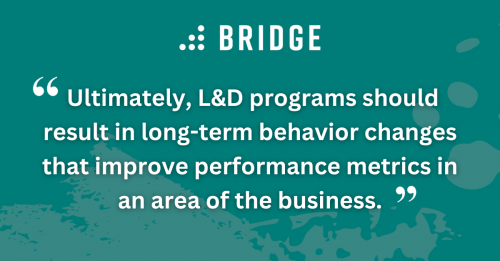
CREATE CONTENT THAT RESONATES | ‘6 Content Curation Best Practices to Maximize the Impact of Your L&D Strategy’
3) Learning Assessment Scores and Completion Rates
Show how learners advance through programs and along learning pathways with assessment scores, completion rates, and quiz scores. Measuring their performance with learning items demonstrates the value of content and how memorable learners find it.
Quiz and assessment scores identify high performers, those most aligned with performance goals, and employees with the potential to advance into senior roles. Conversely, you’ll spot anyone struggling with materials who could benefit from extra support.
Delving into data enables a proactive approach to plug any knowledge gaps that might exist and ensure learners gain greater value from courses.
DOES YOUR CURRENT PLATFORM MEET YOUR NEEDS? | ‘Finding the Right LMS: 7 Questions You Need to Ask’
4) Skills Feedback and Coverage
Your stakeholders need to see the outcome of training initiatives, and 60% of business leaders increasingly recognize the need to up the focus on people and skills to remain successful, according to an EY report.
Ultimately, L&D programs should result in long-term behavior changes that improve performance metrics in an area of the business. A tangible way to justify your L&D strategy is by showing what people have learned and how they apply these skills day to day. When you show the “before” and “after”, and how training drives outcomes such as customer satisfaction or productivity, you demonstrate valuable results.
By conducting skills assessments, performance reviews, and 360 feedback, your organization will create a rounded view of the existing capabilities, how they’re used, and the content that helps people accomplish their goals. You’ll also identify any training gaps or areas for improvement to minimize disruption and create opportunities for learners to leverage their skills and mentor others.
ENHANCE YOUR TALENT MOBILITY STRATEGY | ‘The 5 Pillars of a Successful Talent Mobility Strategy and How to Leverage Them’
5) Employee and Organizational Goal Alignment
Use reporting and analytics to track the effectiveness of training programs and uncover the impact on organizational goals. Segment data by factors such as department, role, or function to inform L&D strategies and reinforce goal alignment.
The data can also shine a light on your strongest performers, the skills they’ve acquired, and those living your company values. Feed these insights into career conversations to identify talent and effectively structure the workforce to tie career and organizational goals together.
Additionally, reporting and analytics helps to minimize bias during performance reviews, provide a rounded view of each employee’s strengths and weaknesses, and give managers visibility into what they might not otherwise see. Managers and employees can use the data to overcome stumbling blocks, keep people on track, and provide clarity around expectations—all of which leads to a boost in performance, according to Gallup.
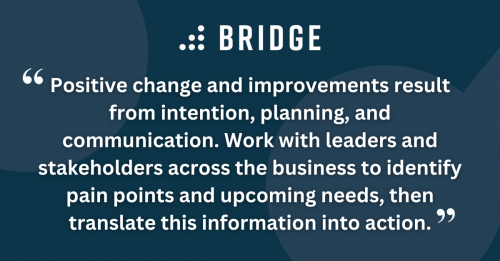
RELATED READING | ‘What Are SMARTER Goals and How Do They Help Measure Employee Productivity?’
6) Employee Engagement Survey Data
An investment in employee engagement can strengthen performance and improve your metrics. Gartner research shows that 71% of organizations that exceed performance on at least one goal ask employees for feedback and act on it, compared to just 52% that don’t.
Whether it’s a conversation or an anonymous survey, collating feedback and starting conversations reveals deeper insights and trends, all of which can inform strategies.
7) Sub-Account Usage
If you produce training materials for a distributed workforce, analytics gives access to how partners and customers engage with the programs. Analytics will allow you to manage enrollment behaviors, remain compliant, and connect the data to performance metrics to address skills gaps.
Access to usage metrics is an effective way to ensure that content is easily available, relevant, and engaging. Tracking course participation, completion, and progress along programs and learning journeys maximizes the value of content for learners outside your organization.
YOU MIGHT ALSO LIKE | ‘5 Reasons to Use an LMS to Train a Distributed Workforce’
How to Show the Business Value of an LMS
Reporting and analytics are most valuable when your organization has a set of precise, transparent, and interconnected goals that each person is working toward.
Here’s how to define and leverage goals to get the most out of data:
1) Identify the Focus Areas
Data drives decisions, but it’s not enough to implement a learning platform and expect the metrics to move in the right direction. Positive change and improvements result from intention, planning, and communication.
Work with leaders and stakeholders across the business to identify pain points and upcoming needs, then translate this information into action.
2) Create and Distribute Training Programs
With clarity about the metrics to move, target those areas with learning and development programs.
By strategically creating and delivering content, you can measure the impact on goals. It also creates more opportunities to forecast and anticipate upcoming changes that require training, minimize disruption, and preempt any skills gaps.
DISCOVER HOW TO START IMPACTFUL CONVERSATIONS | ‘How Can Smart Stay Interview Question Selections Boost Employee Retention?’
3) Review and Distribute the Data
Always collect and gather data in a way that’s relevant to business goals and illustrates the return on investment.
Remember that progress takes time. Share reports of initiatives and outcomes each month to highlight progress and gains from your L&D strategy in a clear and concise format.
4) Adjust Your Strategies
L&D strategies must continuously evolve, informed by results and priorities. Understanding how learners engage with content and how well they retain and apply knowledge helps enhance programs and increase value.
Incorporate qualitative feedback from engagement survey data, one-on-ones, or post-course surveys for key insights into what engages your learners and whether they feel equipped to accomplish their goals.
CREATE TRAINING PROGRAMS WITH EASE | ‘How to Launch a Training Program at Your Organization [The Ultimate Guide]’
Unleash the Full Power of Your L&D Programs With Bridge Analytics
Track, measure, and analyze the impact of training and development programs with Bridge LMS. Deliver training that can drive engagement and greater performance.
Take a data-driven approach to training, show how L&D adds value to your organization, and connect skills, performance management, and employee engagement survey data.
